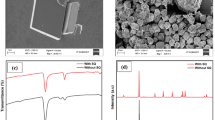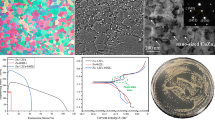Abstract—
This paper reports on the preparation and properties of phosphate materials for medical applications: brushite (CaHPO4·2H2O) or monetite (CaHPO4) based cements prepared from β- and α-Ca3(PO4)2 (TCP) via isomorphous substitutions of Na+ or K+ for Ca2+ and of \({\text{SiO}}_{4}^{{4 - }}\) or \({\text{SO}}_{4}^{{2 - }}\) for \({\text{PO}}_{4}^{{2 - }}\). The mixing liquid used to prepare phosphate cements from substituted TCP was orthophosphoric acid or H2O, and TCP was mixed with dry Ca(H2PO4)2·H2O. Isomorphous substitutions of Na+ and K+ for Ca2+ ions and \({\text{SiO}}_{4}^{{4 - }}\) and \({\text{SO}}_{4}^{{2 - }}\) for \({\text{PO}}_{4}^{{2 - }}\) were confirmed by scanning electron microscopy, X-ray microanalysis, and X-ray diffraction. It has been shown that, as a result of hardening of cement pastes with the use of different mixing liquids, one can obtain materials differing in microstructure, in which brushite or monetite prevails, depending on the TCP phase used in the preparation of the cement. In addition, we have studied interaction of the cements with water for a long time (16 days). The pH of the aqueous medium has been shown to vary from 5 to 7.5. This pH range is favorable for medical applications of the phosphate materials studied.








Similar content being viewed by others
REFERENCES
Gao, C., Peng, S., Feng, P., and Shuai, C., Bone biomaterials and interactions with stem cells, Bone Res., 2017, vol. 5, p. 17059. https://doi.org/10.1038/boneres.2017.59
Putlyaev, V.I. and Safronova, T.V., Chemical transformations of calcium phosphates during production of ceramic materials on their basis, Inorg. Mater., 2019, vol. 55, no. 13, pp. 1328–1341. https://doi.org/10.1134/S0020168519130028
Hench, L.L., Bioceramics, J. Am. Ceram. Soc., 1998, vol. 81, no. 7, pp. 1705–1728. https://doi.org/10.1111/j.1151-2916.1998.tb02540.x
Fernandez de Grado, G., Keller, L., Idoux-Gillet, Y., Wagner, Q., Musset, A.M., Benkirane-Jessel, N., Bornert, F., and Offner, D., Bone substitutes: a review of their characteristics, clinical use, and perspectives for large bone defects management, J. Tissue Eng., 2018, vol. 9, p. 2041731418776819. https://doi.org/10.1177/2041731418776819
Bohner, M., Calcium orthophosphates in medicine: from ceramics to calcium phosphate cements, Injury, 2000, vol. 31, no. 4, pp. 37–47. https://doi.org/10.1016/s0020-1383(00)80022-4
Giulia, B., Sourav, P., Lucia, Sch., Stefano, S., Lisa, B., and Massimo, Del F., The impact of the bioceramic scaffolds on bone regeneration in preclinical in vivo studies: a systematic review, Materials, 2020, vol. 13, no. 7, pp. 1500–1526. https://doi.org/10.3390/ma13071500
Wang, C., Xue, Y., Lin, K., Lu, J., Chang, J., and Sun, J., The enhancement of bone regeneration by a combination of osteoconductivity and osteostimulation using β‑CaSiO3/β-Ca3(PO4)2 composite bioceramics, Acta Biomater., 2012, vol. 8, no. 1, pp. 350–360. https://doi.org/10.1016/j.actbio.2011.08.019
Matsumoto, N., Yoshida, K., Hashimoto, K., and Toda, Y., Dissolution mechanisms of β-tricalcium phosphate doped with monovalent metal ions, J. Ceram. Soc. Jpn., 2010, vol. 118, no. 1378, pp. 451–457. https://doi.org/10.2109/jcersj2.118.451
Goldberg, M.A., Fomin, A.S., Murzakhanov, F.F., Makshakova, O.N., Donskaya, N.O., Antonova, O.S., Gnezdilov, O.I., Mikheev, I.V., Knotko, A.V., Kudryavtsev, E.A., Akhmedova, S.A., Sviridova, I.K., Sergeeva, N.S., Mamin, G.V., Barinov, S.M., Gafurov, M.R., and Komlev, V.S., The improved textural properties, thermal stability, and cytocompatibility of mesoporous hydroxyapatite by Mg2+ do**, Mater. Chem. Phys., 2022, vol. 289, p. 126461. https://doi.org/10.1016/j.matchemphys.2022.126461
Komlev, V.S., Fadeeva, I.V., Gurin, A.N., Kovaleva, A.S., Smirnov, V.V., Gurin, N.A., and Barinov, S.M., Effect of the concentration of carbonate groups in a carbonate hydroxyapatite ceramic on its in vivo behavior, Inorg. Mater., 2009, vol. 45, no. 3, pp. 329–334. https://doi.org/10.1134/S0020168509030194
Safronova, T.V. and Putlyaev, V.I., Powder systems for calcium phosphate ceramics, Inorg. Mater., 2017, vol. 53, no. 1, pp. 17–26. https://doi.org/10.1134/S0020168516130057
Orlov, N.K., Kiseleva, A.K., Mil’kin, P.A., Evdokimov, P.V., Putlyaev, V.I., and Liu, Y., Experimental study of the high-temperature region of the Ca3(PO4)2–CaKPO4–CaNaPO4 system, Russ. J. Phys. Chem., 2021, vol. 95, no. 7, pp. 1302–1306. https://doi.org/10.1134/S0036024421070190
Knotko, A.V., Musoev, Sh.A., and Umirov, U.T., On the feasibility of controlling the micro- and nanostructures of calcium phosphate cements through cation and anion solid-state substitutions, Perspektivnye tekhnologii i materialy. Materialy mezhdunarodnoi nauchno-prakticheskoi konferentsii (Promising Technologies and Materials: Proc. Science and Technology Conf.), Sevastopol: SevGU, 2021, pp. 132–136.
Ando, J. and Matsuno, S., Ca3(PO4)2–CaNaPO4 system, Bull. Chem. Soc. Jpn., 1968, vol. 41, no. 2, pp. 342–347. https://doi.org/10.1246/bcsj.41.342
Fix, W., Heymann, H., and Heinke, R., Subsolidus relations in the system 2CaO·SiO2–3CaO·P2O5, J. Am. Ceram. Soc., 1969, vol. 52, no. 6, pp. 346–347. https://doi.org/10.1111/j.1151-2916.1969.tb11948.x
Author information
Authors and Affiliations
Corresponding author
Ethics declarations
The authors declare that they have no conflicts of interest.
Additional information
Translated by O. Tsarev
Rights and permissions
About this article
Cite this article
Musoev, S.A., Knotko, A.V. Effect of Isomorphous Substitutions in Calcium Triphosphate, Ca3(PO4)2, on the Microstructural and Chemical Properties of Phosphate Cements Prepared from It. Inorg Mater 59, 385–393 (2023). https://doi.org/10.1134/S0020168523040076
Received:
Revised:
Accepted:
Published:
Issue Date:
DOI: https://doi.org/10.1134/S0020168523040076




